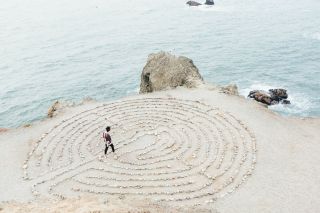Cognition
The Psychology of Death Rituals
How do spiritual and religious traditions impact our relationship with the dead?
Posted March 20, 2023 Reviewed by Vanessa Lancaster
Key points
- Our dualistic beliefs lead to the death superiority effect
- Many cultures don't posit a strict divide between life & death; implications for the death superiority effect
- Ritual can help draw us closer to those that have passed on, enabling us to "break bread with the dead."

This is the second piece in a two-part series about the psychology that drives our relationships with the dead. The first piece focused on how we view the minds of the dead.
How do we relate to the dead? It’s a large question to unpack, but the answer will depend on how you see the relationship between the mind and the brain. It's a massive debate amongst neuroscientists and philosophers: Are the ephemeral mind and the physical brain the same thing? Or are the mind and brain merely related but still somehow separate?
Even if you've never thought much about the question before, you likely find the latter position intuitive. This is dualism: the idea mind and the brain are separate entities. This bias may be human nature, as it’s present even in very young children.
Whether dualism is correct or not is another question altogether. However, this naturally held assumption has significant consequences for our social cognition, specifically when representing the minds of the dead. If we see the physical body, the brain included, as a mere vessel for the mind, it's easy to see how a person's soul can persist when their body dies.
However, as we'll see, these dualistic beliefs create a unique role for the corpse.
How do Tarajon Death Rituals, with their heavy emphasis on retaining the physical body, impact our social cognition? And how does this inform our general views about bonding with dead minds?
Let's dive in.
Dualism and the Death Superiority Effect
Who's mind appears more real to us? An alive individual, in a vegetative state, or a dead person? Common sense indicates that it would be the former. After all, they're the ones who are still alive.

Yet, research by Kurt Gray and colleagues found that people in vegetative states are perceived to have less of a mind than the dead. This is the death superiority effect, a puzzling phenomenon that also stems directly from our dualistic assumptions. If the mind and the brain are separate, then the presence of a body places the focus there and away from the ephemeral mind.
It's a zero-sum contest; the presence of the dead body interferes with our ability to represent their mind.
In contrast, the mind appears more real for the deceased whose corpse is gone and buried. With the body out of sight, there is ample freedom for the wheels of social cognition to churn out vivid representations of the mind.
Along similar lines, people also perceive the mind to be more real in people who have died while still in their prime, as opposed to those who have died while old and bedridden. Similar findings exist for those who passed away while awake and lucid, as opposed to those dying while asleep. And overall, the minds of the deceased and buried appear kinder and more generous as time goes on.
Social Cognition Meets Death Rituals
Overall, our representation of the dead minds is highly subjective and significantly impacted by the presence or absence of the body. How does this square with the Death Rituals of the Torajan?
While speculative, the suggestion is that this prolonged period of interacting with the corpse would make the deceased's mind seem less real. And similarly, when represented, the mind of the dead is more accurate than it otherwise would be.
At the same time, it's essential to zoom out and see the larger cultural picture. In modern, Western traditions, there's a rigid distinction between life and death and a firm line between the two groups. When you're dead, you're dead. If you're lucky, you'll be honored by those still alive, but that's up to them. Your role–and the role of your physical presence, is done.

This sharp distinction, however, is not a universal feature of human nature. It's actually relatively rare across time and cultures. According to the author Dr. Paul Koudounaris, this firm break between life and death is quite unusual in the scope of human history. Most cultures that have existed have conceived of a much softer, fluid relationship. As he described to ABC, "If you look at most cultures in the world still to this day outside the West, if you look at the way Europe used to be, if you look at most ancient cultures, you'll find that they always had a very soft boundary."
The Torojan constitutes precisely this kind of soft, porous boundary. While still in the house, the body isn't described as dead but as "to mukala", or merely sick. At this stage, the person isn't fully alive, isn't fully dead, but is in the gray area in between.
The extensive daily interactions–offering the corpse food, clothing, conversation, and cigarettes may be a means of maintaining the vividness of the relationship. As we've seen in the case of parasocial relationships, we hold other people's relationships in our own heads. It can often be one-way traffic. There need not be an overt response to these gestures for the relationship to feel real.
In Torojan culture, the dead aren't seen as entirely inaccessible. As Koudounaris remarks, "The living and the dead are encouraged to interact. That's what we see in Indonesia, for instance; we're seeing this invitation to cross the border to interact with these people who have passed on."
And so perhaps the prolonged presence of the body, combined with the ritualized exhumation every few years, provides exactly this kind of influence at the level of social cognition. And here, the impact of the physical dead body–the death superiority effect, plays a central role. Their mind may feel more natural when buried, and less so on special occasions when exhumed. These fluctuations make their presence poignant, refreshing them in the minds of living relatives.
In this way, unlike Western traditions, there's never an absolute position to arrive at; no final, resting position for the dead within one's mind and life. Instead, the dead remain a constant and dynamic presence.
Bonding With Dead Minds: Breaking Bread With the Dead
There's a lot to say about the specifics of the Torojan's rituals and their effects on our social cognition. However, there's also a more general point about their enduring relationship with the deceased and the extent to which they remain a lasting presence. The Indonesian writer Putu Sayoga, who spent time with The Tarojan community, echoes these sentiments in The New York Times. He states simply, "The dead never leave us."

This unique kindship points to a different relationship with the deceased, one that may appear foreign to many Western readers. It points to a deep, valuable relationship with one's descendants–even those in the very distant past. The philosopher and writer Alan Jacobs has thought a lot about this question of closeness with past selves. He argues that such a bond provides immense, untapped value. In his book Breaking Bread with the Dead, he writes, “There's an important sense in which we cannot use the past to love ourselves unless we also learn to love our ancestors. We must see them not as others but as neighbors–and then, ultimately, as kin, as members of our (very) extended family.”
As we've seen, our image of the deceased becomes more positive and less accurate over time. Our sense of them drifts off like serendipity. We see how the dead we want to see them; eulogies favor flattery over accuracy. We tend to see only the good and not the full complexity of their humanity, rich with quirks, flaws, and worts. This messiness, however, is the most crucial component. Jacobs continues,
When we own our kinship to those people, they may come alive for us not just as exemplars of narrowness and wickedness that we have overcome, but as neighbors and even as teachers. When we acknowledge that even when they go far astray, they do so in ways that we surely would have, had we been formed as they were, we extend them not just attention but love, the very love that we hope our descendants will extend to us.
There's a lot to say about how we should or shouldn't honor the past and the extent to which we should, or shouldn't connect with our distant ancestors, however foreign they may feel. What should be clear, however, is that the orientation is significant for the here and now.
The minds of the dead matter deeply for the minds of the living.
A version of this post appears on the human nature blog, NeuroScience Of
References
Bloom, P. (2004) Descartes’ Baby: How the Science of Child Development Explains What Makes Us Human (New York: Basic Books, 2004).
Chavez, R.S. (2021). Tangled representations of self and others in the medial prefrontal cortex. In Ochsner, K. & Gilead, M. (Eds.), The Neural Bases of Mentalizing. Springer Press.
Chavez, R.S. & Wagner, D.D. (2020). The neural representation of self is recapitulated in the brains of friends: A round-robin fMRI study. Journal of Personality and Social Psychology, 118(3), 407-416.
Gray, K., Knickman, T. and Wegner, D. (2011) “More Dead Than Dead: Perceptions of Persons in the Persistent Vegetative State,” Cognition 121 (2011): 275–80..
Jacobs, A. (2021). Breaking Bread with the Dead: A Reader's Guide to a More Tranquil Mind. Penguin.
Smitri, D. (May, 2022) What the extraordinary funeral rituals of Tana Toraja and Trunyan in Indonesia can teach us about living a better life, ABC RN
Sayoga, P. (Dec, 2020) In Indonesia, a Blurred Boundary Between The Living and The Dead, The New York Times
Wegner, D., Gray, K. (2014) The Mind Club, Penguin Publishing Group. Kindle Edition.




